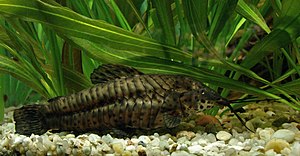Fawn-colored callused catfish
| Fawn-colored callused catfish | ||||||||||||
|---|---|---|---|---|---|---|---|---|---|---|---|---|

Fawn callus catfish ( Megalechis thoracata ), a relatively dark specimen. |
||||||||||||
| Systematics | ||||||||||||
|
||||||||||||
| Scientific name | ||||||||||||
| Megalechis thoracata | ||||||||||||
| ( Valenciennes , 1840) |
The fawn callus catfish or painted callus catfish ( Megalechis thoracata , Syn . : Hoplosternum thoracatum ) is a freshwater ornamental fish from the family of armored and calloused catfish , which is native to South America.
description
This catfish shows the typical characteristics of the callous catfish . The maximum length is 15.5 cm SL . The sides are covered with overlapping scales that are transformed into thick bone plates, which form a fairly stable protective armor. The body cross-section is triangular, the belly flat. The body is compact and the fins are relatively small. The mouth is underneath, elongated and provided with 4 barbels , of which the longer lower ones point straight ahead, the shorter upper ones are placed between the lower ones and used to feel the ground. The pelvic fins are ventral. There is a thorn on the pectoral fins, which is longer in the male than in the female. The dorsal fin is large and rounded at the top, the first ray is significantly shorter than the following. The caudal fin is not notched, slightly rounded outwards and the base is straight, overall it becomes about as long as the head. The coloration can vary from red-brown to brown to almost black, depending on the fish's environment or even its mood. But the black spots are always present all over the body. Like many other fish in his family, he is also capable of intestinal breathing , which allows him to take in oxygen from the air through the intestine as a respiratory organ.
behavior
In general, the fawn calf catfish is a peaceful fish. It is a ground-dwelling omnivore that feeds on both detritus and smaller invertebrates such as insect larvae or Tubifex (larger specimens occasionally prey on small fish). It only becomes aggressive during the mating season .
Reproduction
On the surface of the water, the male looks for a suitable place under leaves or floating plants and builds a foam nest there from air bubbles covered in slime. After a courtship ritual consisting of swimming around the nest together, the female lies on her back and lays the eggs in this nest. After laying its slightly yellowish eggs (up to 800), the male inseminates them and defends them aggressively until the young fish hatch, which occurs after 3 to 4 days. These are independent and feed on small animals such as daphnia and their nauplii . They grow and develop very quickly.
Home and living space
The fawn callus catfish occurs in Brazil and Venezuela. It lives there in the Amazon and Orinoco catchment areas, as well as the upper catchment area of the Río Paraguay and can also be found in coastal rivers in northern Brazil and the three Guyanas . In the shallow pools, the oxygen content of the water often drops sharply, where the intestinal breathing described above helps it to survive.
Aquaristics
In the aquarium it is kept as an ornamental fish similar to the fish of the genus Corydoras , socialization is almost problem-free. It is kept in fairly large warm water pools. The pH value should be kept at 6.5, the hardness should be 5 to 10 ° dGH.
It is often obtained under its synonym Hoplosternum thoracatum or similar names.
Individual evidence
- ↑ Megalechis thoracata in: Roberto E. Reis: Check List of Freshwater Fishes of South and Central America. , P. 305, accessed September 9, 2012
- ↑ a b Claus Schaefer: Pocket atlas aquarium fish. Eugen Ulmer KG, Stuttgart, 2005; under Megalechis personata
- ↑ a b c d Valeria Camaschella: Pesci d'Acquario. German translation: Ruth Karzel, Neuer Kaiser Verlag Gesellschaft mbH Klagenfurt ISBN 978-3-7043-1421-5 in the chapter "Callichthydae" under Hoplosternum thoracatum
- ↑ John H. Gee, Jeffrey B. Graham: Respiratory and Hydrostatic Functions of the Intestine of the Catfishes Hoplosternum thoracatum and Brochis splendens, In: Journal of Experimental Biology 74, 1978, pp. 1-16. ( Online ; PDF; 809 kB)
- ↑ a b Megalechis thoracata on Fishbase.org (English)
- ↑ Megalechis thoracata in the ornamental fish directory ( memento of the original dated November 23, 2012 in the Internet Archive ) Info: The archive link was inserted automatically and has not yet been checked. Please check the original and archive link according to the instructions and then remove this notice. , Excerpt from August 4, 2012
